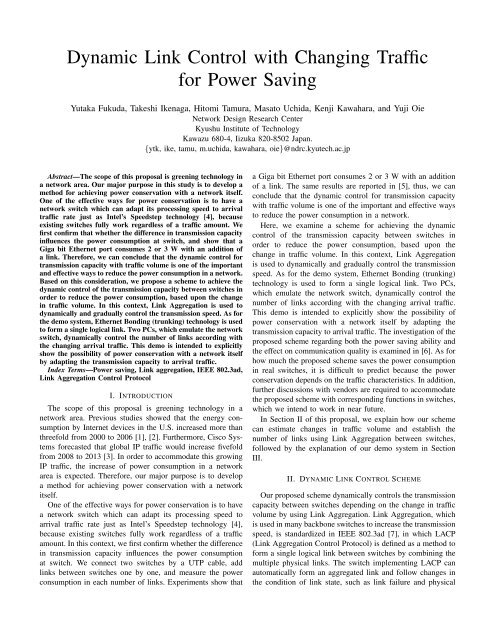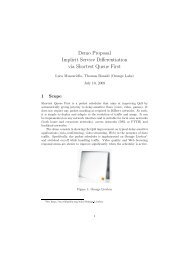Dynamic Link Control with Changing Traffic for Power Saving - LCN
Dynamic Link Control with Changing Traffic for Power Saving - LCN
Dynamic Link Control with Changing Traffic for Power Saving - LCN
You also want an ePaper? Increase the reach of your titles
YUMPU automatically turns print PDFs into web optimized ePapers that Google loves.
<strong>Dynamic</strong> <strong>Link</strong> <strong>Control</strong> <strong>with</strong> <strong>Changing</strong> <strong>Traffic</strong><br />
<strong>for</strong> <strong>Power</strong> <strong>Saving</strong><br />
Yutaka Fukuda, Takeshi Ikenaga, Hitomi Tamura, Masato Uchida, Kenji Kawahara, and Yuji Oie<br />
Network Design Research Center<br />
Kyushu Institute of Technology<br />
Kawazu 680-4, Iizuka 820-8502 Japan.<br />
{ytk, ike, tamu, m.uchida, kawahara, oie}@ndrc.kyutech.ac.jp<br />
Abstract—The scope of this proposal is greening technology in<br />
a network area. Our major purpose in this study is to develop a<br />
method <strong>for</strong> achieving power conservation <strong>with</strong> a network itself.<br />
One of the effective ways <strong>for</strong> power conservation is to have a<br />
network switch which can adapt its processing speed to arrival<br />
traffic rate just as Intel’s Speedstep technology [4], because<br />
existing switches fully work regardless of a traffic amount. We<br />
first confirm that whether the difference in transmission capacity<br />
influences the power consumption at switch, and show that a<br />
Giga bit Ethernet port consumes 2 or 3 W <strong>with</strong> an addition of<br />
a link. There<strong>for</strong>e, we can conclude that the dynamic control <strong>for</strong><br />
transmission capacity <strong>with</strong> traffic volume is one of the important<br />
and effective ways to reduce the power consumption in a network.<br />
Based on this consideration, we propose a scheme to achieve the<br />
dynamic control of the transmission capacity between switches in<br />
order to reduce the power consumption, based upon the change<br />
in traffic volume. In this context, <strong>Link</strong> Aggregation is used to<br />
dynamically and gradually control the transmission speed. As <strong>for</strong><br />
the demo system, Ethernet Bonding (trunking) technology is used<br />
to <strong>for</strong>m a single logical link. Two PCs, which emulate the network<br />
switch, dynamically control the number of links according <strong>with</strong><br />
the changing arrival traffic. This demo is intended to explicitly<br />
show the possibility of power conservation <strong>with</strong> a network itself<br />
by adapting the transmission capacity to arrival traffic.<br />
Index Terms—<strong>Power</strong> saving, <strong>Link</strong> aggregation, IEEE 802.3ad,<br />
<strong>Link</strong> Aggregation <strong>Control</strong> Protocol<br />
I. INTRODUCTION<br />
The scope of this proposal is greening technology in a<br />
network area. Previous studies showed that the energy consumption<br />
by Internet devices in the U.S. increased more than<br />
threefold from 2000 to 2006 [1], [2]. Furthermore, Cisco Systems<br />
<strong>for</strong>ecasted that global IP traffic would increase fivefold<br />
from 2008 to 2013 [3]. In order to accommodate this growing<br />
IP traffic, the increase of power consumption in a network<br />
area is expected. There<strong>for</strong>e, our major purpose is to develop<br />
a method <strong>for</strong> achieving power conservation <strong>with</strong> a network<br />
itself.<br />
One of the effective ways <strong>for</strong> power conservation is to have<br />
a network switch which can adapt its processing speed to<br />
arrival traffic rate just as Intel’s Speedstep technology [4],<br />
because existing switches fully work regardless of a traffic<br />
amount. In this context, we first confirm whether the difference<br />
in transmission capacity influences the power consumption<br />
at switch. We connect two switches by a UTP cable, add<br />
links between switches one by one, and measure the power<br />
consumption in each number of links. Experiments show that<br />
a Giga bit Ethernet port consumes 2 or 3 W <strong>with</strong> an addition<br />
of a link. The same results are reported in [5], thus, we can<br />
conclude that the dynamic control <strong>for</strong> transmission capacity<br />
<strong>with</strong> traffic volume is one of the important and effective ways<br />
to reduce the power consumption in a network.<br />
Here, we examine a scheme <strong>for</strong> achieving the dynamic<br />
control of the transmission capacity between switches in<br />
order to reduce the power consumption, based upon the<br />
change in traffic volume. In this context, <strong>Link</strong> Aggregation<br />
is used to dynamically and gradually control the transmission<br />
speed. As <strong>for</strong> the demo system, Ethernet Bonding (trunking)<br />
technology is used to <strong>for</strong>m a single logical link. Two PCs,<br />
which emulate the network switch, dynamically control the<br />
number of links according <strong>with</strong> the changing arrival traffic.<br />
This demo is intended to explicitly show the possibility of<br />
power conservation <strong>with</strong> a network itself by adapting the<br />
transmission capacity to arrival traffic. The investigation of the<br />
proposed scheme regarding both the power saving ability and<br />
the effect on communication quality is examined in [6]. As <strong>for</strong><br />
how much the proposed scheme saves the power consumption<br />
in real switches, it is difficult to predict because the power<br />
conservation depends on the traffic characteristics. In addition,<br />
further discussions <strong>with</strong> vendors are required to accommodate<br />
the proposed scheme <strong>with</strong> corresponding functions in switches,<br />
which we intend to work in near future.<br />
In Section II of this proposal, we explain how our scheme<br />
can estimate changes in traffic volume and establish the<br />
number of links using <strong>Link</strong> Aggregation between switches,<br />
followed by the explanation of our demo system in Section<br />
III.<br />
II. DYNAMIC LINK CONTROL SCHEME<br />
Our proposed scheme dynamically controls the transmission<br />
capacity between switches depending on the change in traffic<br />
volume by using <strong>Link</strong> Aggregation. <strong>Link</strong> Aggregation, which<br />
is used in many backbone switches to increase the transmission<br />
speed, is standardized in IEEE 802.3ad [7], in which LACP<br />
(<strong>Link</strong> Aggregation <strong>Control</strong> Protocol) is defined as a method to<br />
<strong>for</strong>m a single logical link between switches by combining the<br />
multiple physical links. The switch implementing LACP can<br />
automatically <strong>for</strong>m an aggregated link and follow changes in<br />
the condition of link state, such as link failure and physical
Switch<br />
(3)Advertise the number<br />
of physical links<br />
Switch<br />
TABLE I<br />
THE EQUIPMENT IN DEMO SYSTEM.<br />
Packet<br />
Aggregator<br />
LACPDU<br />
Aggregator<br />
PCs 2<br />
Note PCs 2<br />
Display 1<br />
UTP Cables 10<br />
(1)<strong>Traffic</strong><br />
Measurement<br />
Throughput<br />
Frequency<br />
(2)Estimation<br />
τ<br />
Fig. 1.<br />
(4)Re-<strong>for</strong>ms a logical link<br />
Modification of LACP.<br />
<strong>Control</strong> Interval<br />
τ<br />
Peak<br />
Throughput<br />
x percentile<br />
Next <strong>Link</strong> Speed<br />
Fig. 2.<br />
Estimation Scheme.<br />
τ<br />
Time<br />
link addition by sending LACP DU (Data Unit) packet to the<br />
peer.<br />
Since LACP does not have a function to <strong>for</strong>m a logical<br />
link based on both measurement and estimation of arrival<br />
traffic, we slightly modify LACP as illustrated in Fig. 1 where<br />
modified processes are described as follows:<br />
1) Switch measures the arrival traffic.<br />
2) Switch estimates the number of links in order to satisfy<br />
the traffic demand.<br />
3) Switch sends LACP DU packet to the peer to notify the<br />
number of links to <strong>for</strong>m a new logical link.<br />
4) Peer re-<strong>for</strong>ms a logical link <strong>with</strong> the notified number of<br />
links.<br />
The important key in our scheme is the estimation of the<br />
required transmission capacity, based on the measurement<br />
of arrival traffic. We propose a scheme to determine the<br />
transmission capacity (i.e., the number of links to <strong>for</strong>m a<br />
logical link) based on the peak value of throughput. More<br />
specifically, we estimate the necessary transmission capacity,<br />
using the empirical distribution of peak throughput. Although<br />
we could use the distribution of peak throughput provided <strong>with</strong><br />
a precise statistical analysis method, such as Extreme Value<br />
Theory, a theoretical foundation <strong>for</strong> the analyzing rare events,<br />
we use empirical distribution as a first step <strong>for</strong> realizing our<br />
idea.<br />
Fig. 2 shows the measurement and estimation process in<br />
our scheme. First, the arriving throughput is measured in<br />
a very short term, e.g. 1 millisecond, and peak throughput<br />
values is recorded in each τ period. At the end of each<br />
control interval, an empirical distribution is made from peak<br />
throughput, and next transmission capacity is determined as<br />
it satisfies a predetermined percentile in the distribution. As<br />
the percentile becomes larger, the margin to accommodate<br />
any unexpected increase in traffic volume grows. Finally, the<br />
determined value of transmission capacity is mapped to the<br />
number of links, and the switch <strong>for</strong>ms a new logical link by<br />
sending LACP DU to the peer.<br />
III. DEMO SYSTEM<br />
Our demo is implemented <strong>with</strong> two PCs which emulate the<br />
network switch. In order to provide multiple links between<br />
PCs corresponding <strong>with</strong> switch’s ports, each PC has 2 NICs<br />
which have quad ports. As shown in Fig. 3, each PC is directly<br />
connected to the other by eight UTP cables.<br />
As mentioned in Sec. II, our proposed scheme uses LACP<br />
to dynamically control the transmission capacity between<br />
switches. In order to achieve the same control in the demo<br />
system, Ethernet Bonding (trunking) technology is used to<br />
<strong>for</strong>m a single logical link.<br />
<strong>Traffic</strong> is generated and communicated by two note PCs, via<br />
the two PCs, which emulate network switch <strong>with</strong> our proposed<br />
scheme. Two PCs dynamically control the number of links<br />
according <strong>with</strong> the arrival traffic, which is randomly varied by<br />
traffic generator on note PCs.<br />
Our demo system and GUI are shown in Fig. 4 and Fig. 5.<br />
The left side of Fig. 5 visualizes the active number of links<br />
which is estimated by our proposed scheme based upon the<br />
change in traffic volume. On the right side, presented are the<br />
received traffic ratio, number of link change, drop packet, and<br />
delay of link. Required space is 180 × 90 cm, in which<br />
the two PCs and two note PCs are deployed. Setup time is<br />
approximately one hour. Our demo system, consisted of two<br />
PCs, two note PCs, and a display, requires approximately<br />
15 ampere of power. Wired internet access is needed <strong>for</strong><br />
PC’s maintenance. The equipments used in our demo are<br />
summarized in Table I.
ACKNOWLEDGMENT<br />
This work was supported in part by the Ministry of Education,<br />
Culture, Sports, Science and Technology, Grant-in-Aid<br />
<strong>for</strong> Young Scientists (B)(No. 21700081), and in part by the<br />
GreenIT Project by the New Energy and Industrial Technology<br />
Development Organization (NEDO).<br />
REFERENCES<br />
[1] M. Gupta, S. Singh, “Greening of the Internet, ”Proc. of ACM SIG-<br />
COMM ’03, pp. 19–26, August 2003.<br />
[2] B. Nordman, “Networks, Energy, and Energy Efficiency,” presentation<br />
at Cisco Green Research Symposium, March 2008.<br />
[3] Cisco Systems,<br />
http : //newsroom.cisco.com/dlls/2009/prod 0 60909.html, June<br />
2009<br />
[4] S. Gochman, R. Ronen, I. Anati, A. Berkovits, T. Kurts, A. Naveh,<br />
A. Saeed, Z. Sperber, and R. C. Valentine, “The Intel Pentium M Processor:<br />
Microarchitecture and Per<strong>for</strong>mance,” Intel Technology Journal,<br />
V.7, Issue 2, 2003.<br />
[5] C. Gunaratne, K. Christensen, B. Nordman, “Managing energy consumption<br />
costs in desktop PCs and LAN switches <strong>with</strong> proxying, split TCP<br />
connections, and scaling of link speed,” International Journal of Network<br />
Management Volume 15, Issue 5, pp. 297-310, September 2005.<br />
[6] Y. Fukuda, T. Ikenaga, H. Tamura, M. Uchida, K. Kawahara, and<br />
Y. Oie, “Per<strong>for</strong>mance Evaluation of <strong>Power</strong> <strong>Saving</strong> Scheme <strong>with</strong> <strong>Dynamic</strong><br />
Transmission Capacity <strong>Control</strong>,” to be appeared in 2nd International<br />
Workshop on Green Communications, December 2009.<br />
[7] IEEE 802.3ad <strong>Link</strong> Aggregation Task Force,<br />
http : //www.ieee802.org/3/ad/index.html<br />
Fig. 3.<br />
Two PCs are connected by eight cables <strong>with</strong> each other.<br />
Fig. 4.<br />
Demo System.<br />
Fig. 5.<br />
GUI.







